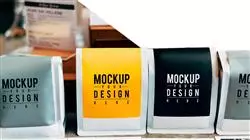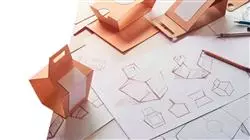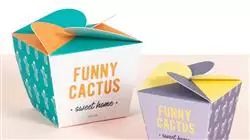University certificate
The world's largest faculty of design”
Why study at TECH?
Learn, from the best multimedia didactic resources, the best techniques of Conceptual Design applied to Packaging, and immediately advance your professional career thanks to this TECH program"

The Packaging Design process of a product is as important as the product itself, since it is going to be a fundamental element in its commercialization and in its elaboration. Thus, more and more companies are paying attention to this area and are looking for specialists who know how to contribute new ideas to improve sales, distribution and streamline the process of creating these elements. Therefore, this program is perfect for the designer who wants to enter this booming field.
Throughout 4 specialized modules, the professional will have the opportunity to delve into issues such as the configurational organization of the image, design methodologies based on bionics, contemporary aesthetics or the analysis of the specific needs of shape, color, smell, volume and textures, packaging ergonomics, among many others.
The designer will also enjoy a 100% online teaching methodology that will allow him to combine his work and other daily obligations with his studies. Without fixed schedules, without uncomfortable travel and with the best multimedia resources: videos, theoretical-practical activities, interactive summaries and master classes.
You will delve into issues such as sustainability applied to Packaging
and the aesthetic principles that dominate Contemporary Design"
This Postgraduate diploma in Conceptual Packaging Design contains the most complete and up-to-date program on the market. The most important features include:
- The development of case studies presented by experts in Design Conceptualization.
- The graphic, schematic, and eminently practical contents with which they are created, provide scientific and practical information on the disciplines that are essential for professional practice.
- Practical exercises where self-assessment can be used to improve learning.
Its special emphasis on innovative methodologies - Theoretical lessons, questions to the expert, debate forums on controversial topics, and individual reflection assignments
- Content that is accessible from any fixed or portable device with an Internet connection
Videos, interactive summaries, different practical activities, master classes,
etc. The best didactic resources will be at your at your disposal so that you can specialize in Conceptual Packaging Design "
The program’s teaching staff includes professionals from the sector who contribute their work experience to this training program, as well as renowned specialists from leading societies and prestigious universities.
Its multimedia content, developed with the latest educational technology, will allow the professional a situated and contextual learning, that is, a simulated environment that will provide an immersive training programmed to train in real situations.
This program is designed around Problem-Based Learning, whereby the professional must try to solve the different professional practice situations that arise during the academic year. For this purpose, the student will be assisted by an innovative interactive video system created by renowned and experienced experts.
You will have at your disposal all the program materials 24 hours a day, since TECH's teaching system is completely adapted to your obligations and needs"

This program will provide you with the theoretical and methodological bases to Conceptualize Packaging Design"
Syllabus
This Postgraduate diploma in Conceptual Packaging Design has been created by leading specialists in this field, who have been in charge of gathering the most advanced knowledge in this area. Thus, from 4 specific modules, the student will be able to delve into issues such as the emotional effects of different colors, the syntactic foundations of visual literacy or the description of the product-system and the life cycle of a wrapper or package.

The fundamental principles of Conceptual Packaging Design are at your fingertips with this Postgraduate diploma, which brings together highly specialized content in this creative area"
Module 1. Color and Shape
1.1. Color Theory
1.1.1. Perception of Form and Space
1.1.2. Color. Definition
1.1.3. Color Perception
1.1.4. Color Properties or Dimensions
1.1.5. Color Classification
1.2. Color Perception
1.2.1. The Human Eye
1.2.2. Color Vision
1.2.3. Variables in Color Perception
1.2.4. Non-Visual Color Perception
1.3. Color Modeling and Standardization
1.3.1. History of Color
1.3.1.1. First Theories
1.3.1.2. Leonardo Da Vinci
1.3.1.3. Isaac Newton
1.3.1.4. Moses Harris
1.3.1.5. Goethe
1.3.1.6. Runge
1.3.1.7. Chevreul
1.3.1.8. Rood
1.3.1.9. Munsell
1.3.1.10. Ostwald
1.3.2. Visual Perception
1.3.2.1. Absorption and Reflection
1.3.2.2. Pigment Molecules
1.3.3. Color Attributes
1.3.3.1. Tone
1.3.3.2. Luminance
1.3.3.3. Saturation
1.3.4. Warm and Cool Colors
1.3.5. Harmony in Colors
1.3.6. Contrast
1.3.7. Color Effects
1.3.7.1. Size
1.3.7.2. Transparency, Weight and Mass
1.4. Semiotics and Semantics of Color
1.4.1. Semiotics of Color
1.4.2. Color Description
1.4.3. Colors: Material, Light, Perceptions and Sensations.
1.4.4. Color and Material
1.4.5. The Truth of a Color
1.4.6. Color Perception
1.4.7. The Weight of a Color
1.4.8. The Color Dictionary
1.5. Color in Design
1.5.1. Chromatic Trends
1.5.2. Graphic Design
1.5.3. Interior Design
1.5.4. Architecture
1.5.5. Landscape Design
1.5.6. Fashion Design
1.6. Composition
1.6.1. General Aspects
1.6.1.1. Codes Used
1.6.1.2. Degree of Originality and Banality
1.6.1.3. Degree of from Iconicity and Abstraction
1.6.2. Configurational Organization of the Image: Relation between Background and Figure
1.6.3. Configurational Organization of the Image: Gestalt Laws
1.6.4. Configurational Organization of the Image: Systems of Spatial Organization
1.6.4.1. Balance: Static or Dynamic. Focal or Orthogonal System
1.6.4.2. Proportion
1.6.4.3. Symmetry
1.6.4.4. Movement and Rhythm
1.6.5. Field Study
1.7. Image Functions
1.7.1. Representative
1.7.1.1. Cartographic
1.7.1.2. Scientist
1.7.1.3. Architectural
1.7.1.4. Projectual
1.7.2. Persuasive
1.7.3. Artistic
1.8. Color Psychology
1.8.1. Warm Colors and Cool Colors
1.8.2. Physiological Effects
1.8.3. Color Symbolism
1.8.4. Personal Color Preferences
1.8.5. Emotional Effects
1.8.6. Local Color and Expressive
1.9. The Meaning of Color
1.9.1. Blue
1.9.2. Red
1.9.3. Yellow
1.9.4. Green
1.9.5. Black
1.9.6. White
1.9.7. Orange
1.9.8. Violet
1.9.9. Pink
1.9.10. Gold
1.9.11. Silver
1.9.12. Brown
1.9.13. Gray
1.10. Color Use
1.10.1. Sources of Dyes and Pigments
1.10.2. Lighting
1.10.3. Mixture of Oils and Acrylics
1.10.4. Glazed Ceramics
1.10.5. Colored Glass
1.10.6. Color Printing
1.10.7. Color Photography
Module 2. Project Theory and Methodology
2.1. Theory, Methodology, Ideation and Project Conception
2.1.1. The Design Sectors
2.1.1.1. Communication Graphic Design
2.1.1.2. Environment Interior Design
2.1.1.3. Objects. Industrial Design
2.1.1.4. Clothing Fashion Design
2.1.2. What is a Problem?
2.1.3. Design problems
2.1.4. Sketches and Drawings
2.1.5. Models
2.1.6. Analysis Sheet
2.2. Research Methods and Experimentation
2.2.1. Introduction to Research
2.2.2. Areas of Research
2.2.3. Elements of Research
2.2.4. Research Methods
2.2.5. Role of Research
2.3. Introduction to Visual Alphabet
2.3.1. Syntactic Foundations of Visual Literacy
2.3.2. Basic Elements of Visual Communication
2.3.3. Anatomy of Visual Language
2.3.4. Visual Techniques
2.4. Introduction to Bionics
2.4.1. Definition and Concept of Bionics
2.4.1.1. Scope of Application
2.4.2. Project Methodologies Based on Bionics
2.4.2.1. Approach and Case Studies
2.4.2.2. Analogies, Classification and Types of Analogy
2.4.3. Design, Ecological and Efficient
2.4.3.1. Product Life Cycle
2.4.3.2. Obsolescence Concept
2.4.3.3. Recycle and Reuse
2.5. Ergonomics Applied to Design
2.5.1. Introduction to Ergonomics
2.5.2. Ergonomics and Design
2.5.3. Ergonomics Factors
2.5.3.1. Objectual
2.5.3.2. Environmental Leadership.
2.5.3.3. Sociocultural
2.5.3.4. Psychological Criteria
2.5.3.5. Anthropometric
2.5.4. Ergonomic Methods and Techniques
2.6. Introduction to Anthropometry
2.6.1. General Introduction
2.6.2. Static and Dynamic Anthropometry
2.6.3. Measurements and Anthropometric Data
2.6.4. Human Variability Determinants
2.6.5. Reference Planes of the Human Body
2.6.6. Anthropometric Tables
2.7. Dichotomy between Art and Design
2.7.1. What is Art? and What is design?
2.7.2. Isabel Campi
2.7.3. Norberto Chaves
2.7.4. Ana Herrera
2.7.5. Óscar Salinas
2.7.6. Yves Zimmermann
2.8. Briefing
2.8.1. Briefing Description
2.8.2. Types of Briefing
2.8.3. Elements of the Briefing
2.8.4. Development of the Briefing
2.9. Typography
2.9.1. Origins of Typography
2.9.2. Readability
2.9.3. Lettering and Calligraphy
2.9.4. Lettering for Printing
2.9.5. Composition Systems
2.10. Documentary Research and Bibliographic Studies
2.10.1. Generate a Research Project
2.10.2. The Bibliographic Study
2.10.3. APA Standards
Module 3. Aesthetics
3.1. Origin and Antiquity of Aesthetics
3.1.1. Definition of Aesthetics
3.1.2. Platonism
3.1.3. Aristotelianism
3.1.4. Neoplatonism
3.2. Mimesis, Poiesis and Katharsis
3.2.1. Mimesis
3.2.2. Poiesis
3.2.3. Katharsis
3.3. Middle and Modern Ages
3.3.1. Scholasticism
3.3.2. The Renaissance
3.3.3. Mannerism
3.3.4. Baroque
3.3.5. Rationalism
3.3.6. Empiricism
3.3.7. Enlightenment
3.3.8. Idealism
3.4. The Definition of Art Today
3.4.1. Art
3.4.2. The Artist
3.4.3. Taste and Criticism
3.4.4. Fine Arts
3.5. Fine Arts
3.5.1. Architecture
3.5.2. Sculpture
3.5.3. Painting
3.5.4. Music
3.5.5. Poetry
3.6. Aesthetics and Reflection
3.6.1. Positivist Aesthetics
3.6.2. Idealist Aesthetics
3.6.3. Critical Aesthetics
3.6.4. Libertarian Aesthetics
3.7. Aesthetics and Ethics
3.7.1. Illustration
3.7.2. Idealism
3.7.2.1. Kant
3.7.2.2. Schiller, Fichte, Schelling
3.7.2.3. Hegel
3.7.3. Romanticism
3.7.3.1. Kierkegaard, Schopenhauer y Wagner
3.7.3.2. Nietzsche
3.8. Aesthetics and Taste
3.8.1. Aesthetic Taste as an Illustrated Theoretical Statute
3.8.2. A Taste for Impact
3.8.3. The Aestheticization of Taste
3.9. Contemporary Aesthetics
3.9.1. Formalism
3.9.2. Iconology
3.9.3. Neoidealism
3.9.4. Marxism
3.9.5. Pragmatism
3.9.6. Noucentisme
3.9.7. Raciovitalism
3.9.8. Logical Empiricism
3.9.9. Semiotics
3.9.10. Phenomenology
3.9.11. Existentialism
3.9.12. Postmodern Aesthetics
3.10. Aesthetic Categories
3.10.1. Beauty
3.10.2. Ugliness
3.10.3. Sublime
3.10.4. Tragic
3.10.5. Comical
3.10.6. Grotesque
Module 4. Packaging Design
4.1. Introduction to Packaging
4.1.1. Historical Perspective
4.1.2. Functional Characteristics
4.1.3. Description of System-Product and Life Cycle
4.2. Packaging Research
4.2.1. Sources of information
4.2.2. Field Work
4.2.3. Comparisons and Strategies
4.3. Structural Packaging
4.3.1. Analysis of Specific Needs
4.3.2. Shape, Color, Smell, Volume and Textures
4.3.3. Packaging Ergonomics
4.4. Packaging Marketing
4.4.1. Relationship of the Pack with the Brand and the Product
4.4.2. Brand Image Application
4.4.3. Examples:
4.5. Packaging Communication
4.5.1. Relationship of the Pack with the Product, the Customer and the User
4.5.2. Relationship of the Pack with the Product, the Customer and the User
4.5.3. Experience Design
4.6. Materials and Production Processes
4.6.1. Glass
4.6.2. Paper and Cardboard
4.6.3. Metal
4.6.4. Plastic fluids
4.6.5. Natural Materials Composites
4.7. Sustainability Applied to Packaging
4.7.1. Ecodesign Strategies
4.7.2. Life Cycle Analysis
4.7.3. The Pack as Waste
4.8. Food Legislation
4.8.1. Specific Regulations: Identification and
4.8.2. Plastics Regulations
4.8.3. Regulatory Trends
4.9. Innovation in Packaging
4.9.1. Differentiation with Packaging
4.9.2. Latest Trends
4.9.3. Design For All
4.10. Packaging Projects
4.10.1. Study Cases
4.10.2. Packaging Strategy
4.10.3. Practical Exercise

This program not only has the best teaching methodology, but also presents the most up-to-date syllabus in one of today's fastest growing areas of design"
Postgraduate Diploma in Conceptual Packaging Design
.
Packaging design is a discipline that combines creativity and functionality to create attractive and efficient products. This tool has become an essential factor in the business world, since the packaging represents the first impression of a product; which contributes to make a solid difference between the success or failure of a brand. From TECH Global University we propose a complete Postgraduate Diploma in Conceptual Packaging Design that, in addition to providing you with the most complete and updated contents in the market, includes an innovative relearning methodology. The Postgraduate Diploma is completely online and brings together the most sophisticated learning techniques, with a select curriculum that addresses in various modules everything you need to know about the conceptual design of packaging. Our study plan makes use of state-of-the-art graphic, audiovisual and interactive material, which you will have within reach of any device connected to the Internet. In this way, you will be able to design and develop innovative, efficient and sustainable packaging.
Get certified as a specialist in conceptual packaging design
.
This program was strategically designed to provide you with the best academic experience. Our comprehensive curriculum will take you from graphic design, materials, production and technology, to marketing to develop high quality packaging that meets customer and consumer needs. You will also delve into prototyping, project management and technology. With this training, you will succeed in developing innovative and functional packaging that meets brand needs, establishing a key competitive advantage in the business world.







